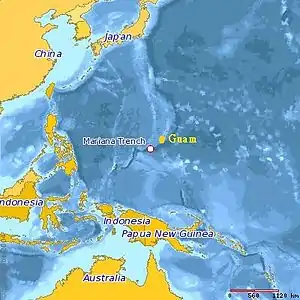Sirena Deep
The Sirena Deep, originally named the HMRG Deep, was discovered in 1997[1][2] by a team of scientists from Hawaii.[2] Its directly measured depth of 10,714 m (35,151 ft) is third only to the Challenger Deep and Horizon Deep, currently the deepest known directly measured places in the ocean.[3][4][5] It lies along the Mariana Trench, 200 kilometers to the east of the Challenger Deep and 145 km south of Guam.[1][2]


Formation
The Sirena Deep was most probably formed, not through transform fault motion as previously thought, but through a north-south convergence of the Caroline plate and the Pacific plate, in which the Caroline plate is subducting.[3] A group of scientists have hypothesized that the great depth of the Mariana Trench, the Challenger Deep, and the Sirena Deep is due to a tear in the subducting Caroline plate, causing deformation of the Pacific plate above.[3] This tear would be located to the south of Guam, the same location of the deepest portion of the Mariana Trench.[3] The tear would lead to unusual regional tectonics, another possible reason for the extreme depth.[3] Scientists were alerted to the presence of the tear by the depth of strike-slip earthquakes, which were occurring too deep for them to be in the overriding plate.
The Sirena Deep lies at the intersection of the East Santa Rosa Bank Fault and a trench axis south of Guam.[3]
History
Discovery
In 1997, the Hawaiʻi Mapping Research Group (HMRG) conducted a detailed sonar survey of the seafloor around Guam, discovering what is believed to be the second or third deepest[4][5][6] location in the world's oceans; its existence was confirmed in 2001 and it was temporarily named HMRG Deep.[2][6] In the same research mission, scientists found previously undiscovered faults, landslides, and mud volcanoes.[2]
The data that confirmed the discovery were collected using the HAWAII MR1 mapping system. This mapping system has the ability to record both bathymetry and sidescan data at the same time. The two vessels that this system was used on were RIV Moana Wave in 1997 and RIV Melville in 2001.[3]
Renaming
After a competition was held by Dr. Patricia Fryer, her doctoral student Sam Hulme, and Linda Tatreau to rename the HMRG Deep,[6] the new name of Sirena Deep was chosen. Students from Guam and the Northern Mariana Islands ages 18 and younger competed,[6][7] with the winning name being suggested by Jermaine Sanders (aged 16) and John Meno (aged 14). The new name references the Guam legend of Serena, a young girl turned into half fish because of her disobedience. The new name will now appear on geologic and bathymetric maps.
Crewed descent

On 7 May 2019 Victor Vescovo (Pilot) and Dr. Alan Jamieson (Chief Scientist) made the first crewed descent to the bottom of the Sirena Deep in the Deep-Submergence Vehicle DSV Limiting Factor (a Triton 36000/2 model submersible) and measured a depth of 10,714 m (35,151 ft) ±10 m (33 ft) by direct CTD pressure measurements. This descent occurred just after descending four times to the bottom of the nearby Challenger Deep. Work focused on geological, biological and video survey and collection in the Mariana Trench basin. They spent 176 minutes on the bottom of the Sirena Deep and the deepest piece of mantle rock ever recovered from the surface of the western slope of the Mariana Trench was collected.[8][9] The Mariana Trench and the operating area was surveyed by the support ship, the Deep Submersible Support Vessel DSSV Pressure Drop, with a Kongsberg SIMRAD EM124 multibeam echosounder system. The gathered data will be donated to the GEBCO Seabed 2030 initiative.[10][11] The dive was part of the Five Deeps Expedition. The objective of this expedition is to thoroughly map and visit the deepest points of all five of the world's oceans by the end of September 2019.[12]
References
- Sukola, Tiffany. "Last chance to get 'your name' in the books". Retrieved 15 August 2009.
- Whitehouse, David (12 July 2003). "Sea floor survey reveals deep hole". BBC News. Retrieved 9 August 2009.
- Patricia Fryer; Nathan Becker; Bruce Appelgate; Fernando Martinez; Margo Edwards; Gerard Fryer (2003). "Why is the Challenger Deep So Deep?". Earth and Planetary Science Letters (published 29 May 2003). 211 (3–4): 259–269. Bibcode:2003E&PSL.211..259F. doi:10.1016/S0012-821X(03)00202-4.
- Wright, Dawn J., Sherman H. Bloomer, Christopher J. MacLeod, Brian Taylor, & Andrew M. Goodlife (2001). "Bathymetry of the Tonga Trench and Forearc: a map series" (PDF). Marine Geophysical Researches. 21 (5): 489–511. Bibcode:2000MarGR..21..489W. doi:10.1023/A:1026514914220.CS1 maint: multiple names: authors list (link)
- Steve Nicholls (producer/writer), Victoria Coules (writer), Peter Brownlee (editor) (9 August 2009). Drain the Ocean (Documentary). National Geographic.
- Flores, J.T. "Guam gets to name trench spot". Retrieved 15 August 2009.
- "DEEPSEA CHALLENGE - Marianas Trench Marine National Monument". 24 March 2012. Retrieved 21 September 2016.
- Deepest Ever Submarine Dive Made by Five Deeps Expedition
- "Deepest Submarine Dive in History, Five Deeps Expedition Conquers Challenger Deep" (PDF). fivedeeps.com. Retrieved 13 May 2019.
- The Nippon Foundation-GEBCO Seabed 2030 Project
- "Major partnership announced between The Nippon Foundation-GEBCO Seabed 2030 Project and The Five Deeps Expedition". gebco.net. 11 March 2019. Retrieved 19 June 2019.
- "Home". fivedeeps.com. Retrieved 9 January 2019.
External links
- former HMRG homepage, under the University of Hawaii
- HIGP homepage (Hawaiʻi Institute of Geophysics and Planetology), also under the University of Hawaii